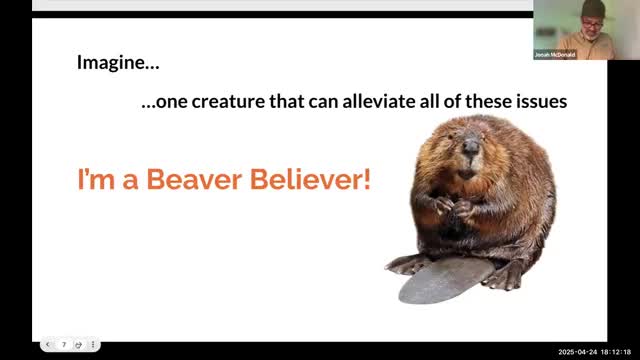DeKalb County Naturalist discusses beaver ecology and coexistence strategies
April 27, 2025 | Milton, Fulton County, Georgia
This article was created by AI summarizing key points discussed. AI makes mistakes, so for full details and context, please refer to the video of the full meeting. Please report any errors so we can fix them. Report an error »

On April 27, 2025, a government meeting in Milton, Fulton County, Georgia, focused on the fascinating world of beavers, highlighting their ecological significance and the challenges of human-beaver coexistence. The session, titled "Wood You Believe It? Everything You Want to Know About Beavers," featured a presentation by a local naturalist who shared insights into the history, anatomy, and behavior of these remarkable creatures.
The discussion began with a historical overview of beavers in North America, noting that prior to European colonization, estimates suggested there were between 50 to 400 million beavers across the continent. However, due to extensive hunting for their pelts—particularly for fashionable felt hats—beaver populations plummeted to an estimated 6 to 12 million today. The naturalist emphasized that while beavers were extirpated from certain areas, such as Connecticut in the mid-1800s, successful reintroduction efforts have since restored their presence in many regions.
The presentation also delved into the anatomy of beavers, highlighting their unique adaptations. For instance, their orange teeth, which contain iron, are designed for gnawing wood, while their flat tails serve multiple functions, including fat storage and signaling danger. The naturalist explained that beavers are social animals, living in family groups that work together to maintain their habitats, which they create by building dams and canals.
A significant portion of the meeting was dedicated to the challenges of human-beaver interactions. The naturalist acknowledged that while beavers create vital wetland habitats, their activities can lead to conflicts with human interests, such as flooding and tree damage. The discussion underscored the importance of finding ways for humans and beavers to coexist, as both species play crucial roles in shaping their environments.
In conclusion, the meeting highlighted the need for greater awareness and understanding of beavers and their ecological contributions. As communities continue to grow and develop, fostering a harmonious relationship with these industrious rodents will be essential for preserving local ecosystems. The naturalist's engaging presentation not only educated attendees about beavers but also sparked a conversation about the importance of biodiversity and conservation efforts in the region.
The discussion began with a historical overview of beavers in North America, noting that prior to European colonization, estimates suggested there were between 50 to 400 million beavers across the continent. However, due to extensive hunting for their pelts—particularly for fashionable felt hats—beaver populations plummeted to an estimated 6 to 12 million today. The naturalist emphasized that while beavers were extirpated from certain areas, such as Connecticut in the mid-1800s, successful reintroduction efforts have since restored their presence in many regions.
The presentation also delved into the anatomy of beavers, highlighting their unique adaptations. For instance, their orange teeth, which contain iron, are designed for gnawing wood, while their flat tails serve multiple functions, including fat storage and signaling danger. The naturalist explained that beavers are social animals, living in family groups that work together to maintain their habitats, which they create by building dams and canals.
A significant portion of the meeting was dedicated to the challenges of human-beaver interactions. The naturalist acknowledged that while beavers create vital wetland habitats, their activities can lead to conflicts with human interests, such as flooding and tree damage. The discussion underscored the importance of finding ways for humans and beavers to coexist, as both species play crucial roles in shaping their environments.
In conclusion, the meeting highlighted the need for greater awareness and understanding of beavers and their ecological contributions. As communities continue to grow and develop, fostering a harmonious relationship with these industrious rodents will be essential for preserving local ecosystems. The naturalist's engaging presentation not only educated attendees about beavers but also sparked a conversation about the importance of biodiversity and conservation efforts in the region.
View full meeting
This article is based on a recent meeting—watch the full video and explore the complete transcript for deeper insights into the discussion.
View full meeting
